Droughts and Floods in the La Plata Basin in Soil Moisture Data and GRACE
Abstract
:1. Introduction
2. Study Area: La Plata Basin, South America
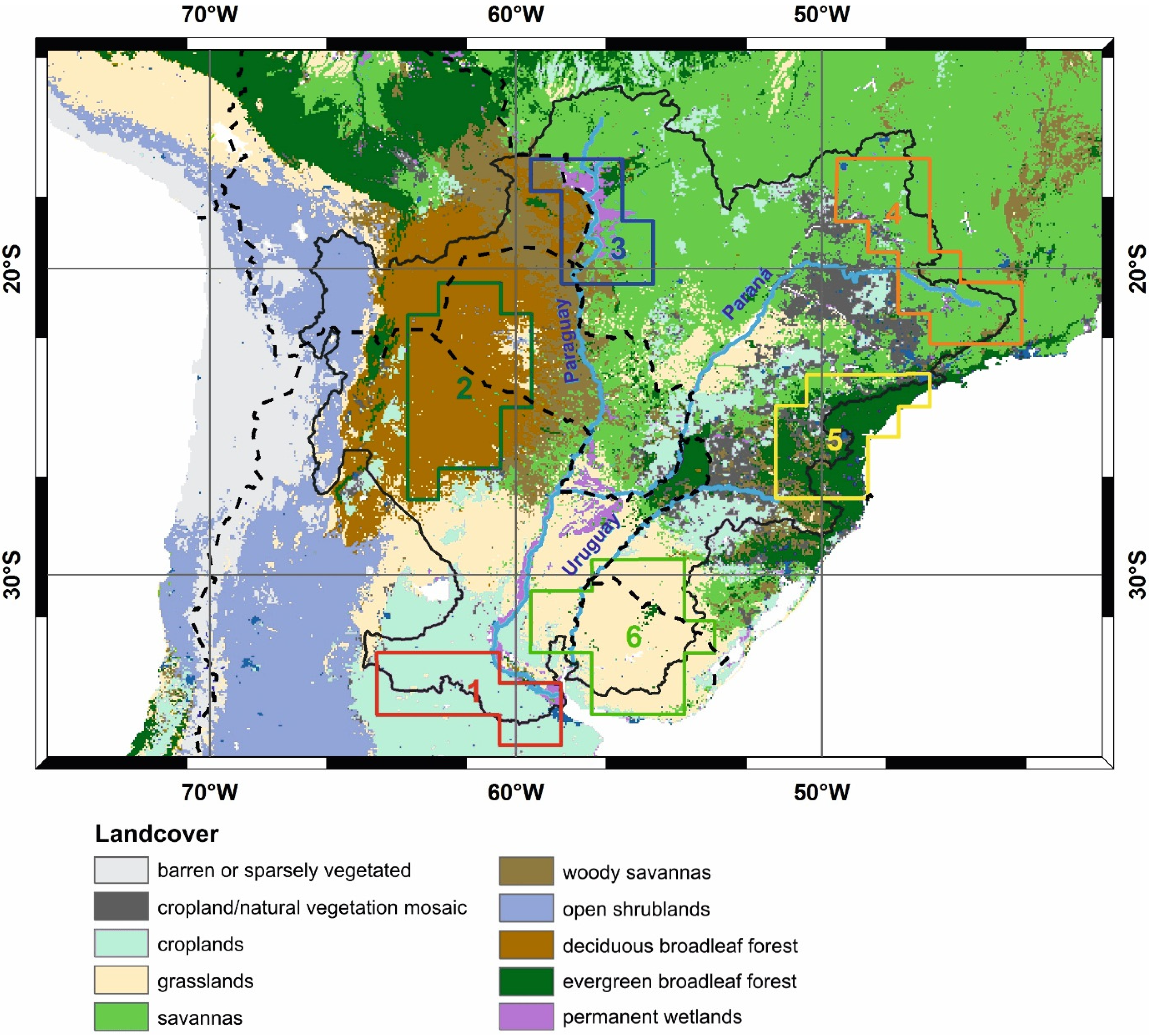
- Southern cropland (Pampas; Figure 1, sub-region 1) and southern grassland (Campos; Figure 1, sub-region 6): The Pampas and the Campos are two major sub-regions of the major South American grassland, which stretches from the south of Brazil to Argentina, comprising more than 700,000 km2. The climate changes from west to east from humid to dry-subhumid [32]. The plain contains the most fertile soils of the La Plata Basin. The Campos has continental climate with frequent frost in winter and daily maximum temperature above 36 °C in summer. Rainfall is distributed throughout the year but changes strongly between years [33]. The annual mean precipitation in the North (1600 mm) is larger than in the South (1200 mm). The Campos is mainly used for grassland-based livestock production [34]. This is different for the Pampas. This region is intensively used by agriculture. The climate is similar to the Chaco with the main precipitation falling from October to March.
- Western deciduous broadleaf forest (Chaco; Figure 1, sub-region 2): The Chaco is a subtropical area and located west of the Paraguay River and east of the Andes [35]. It is the warmest region in the La Plata Basin. In summer, the daily maximum temperature often exceeds 45°. The rainy season usually takes place between September and April. The semi-arid plains of the Chaco are dominated by dry woodland, which (approaching to the east) transform into more open savannas (Figure 1).
- Wetland Pantanal (Figure 1, sub-region 3): The Pantanal is one of the world’s largest wetlands with enormous biodiversity, covering about 100,000 km2 of the Paraguay Basin [36]. It behaves as a regulator for the entire La Plata Basin, by slowing the streamflow of the Paraguay River before its junction with the Paraná River [29]. Annual totals of precipitation exceed 1300 mm. In December, the precipitation maximum takes place, reaching about 200 mm. In July and August, the precipitation is close to zero [37].
- Northern savanna (Cerrado; Figure 1, sub-region 4): The Cerrado is a rather moist savanna region with an average annual precipitation of around 1500 mm. The climate is seasonal with a very strong dry period, spanning from April to September. The temperatures are mild, ranging from 22° to 27°. Large parts of the Cerrado have been transformed into pasture or are used for cash cropping [38].
- Eastern evergreen broadleaf forest (Mata Atlantica; Figure 1, sub-region 5): Originally the Atlantic forest was one of the world’s largest rainforests, covering approximately 150 million ha. Nowadays, only smaller fragments exist due to intensive deforestation and agricultural use [39]. The region has the highest average annual precipitation (above 2000 mm) in the La Plata Basin [30] and receives precipitation during the whole year. The climate is tropical to subtropical. The month of maximum precipitation varies from north (boreal summer) to south (boreal winter). Therefore, the annual cycle of precipitation for the whole region shows three peaks [40]: one at the beginning of spring, one in the middle of summer, and one in winter (with respect to boreal seasons). Due to the height of the region, frost occurs frequently during winter and precipitation may fall in some sub-region as snow (e.g., high places of Santa Cantarina State).
3. Data
| Satellite Gravimetry | Remote Sensing | Hydrological Model | ||
|---|---|---|---|---|
| Source | GRACE | ASCAT | AMSR-E | WGHM |
| Product | Level 2, RL05, German Research Centre for Geosciences (GFZ) | Level 2 Soil Moisture at 25 km Swath Grid EUMETSAT, Vienna University of Technology (TU Wien) | LPRM/AMSR-E/Aqua Daily L3 Surface Soil Moisture, Vrije Universiteit Amsterdam, and NASA GSFC | Version 2.2, German Research Centre for Geosciences (GFZ), University of Frankfurt |
| Reference | [41] | [42] | [43] | [44] |
| Parameter | change in total water storage | surface soil moisture | surface soil moisture | root zone soil moisture, precipitation |
| Availability | 2002–present | 2007–present | 2002–2011 | 1901–present |
| Temporal Resolution | monthly | daily | daily | monthly |
| Spatial Resolution | 300 km | 25 km | 25 km | 0.5° |
| Coverage | global | global | global | global |
| Unit | mm | % (0% dry, 100% wet) | m3/ m3 | mm |
| Representation | Spherical harmonic coefficients | Ascending and descending tracks | 0.25° world map with descending tracks | 0.5° world map |
3.1. Satellite Soil Moisture
3.2. WaterGAP Global Hydrology Model (WGHM)
3.3. GRACE
3.4. El Niño/La Niña Index
3.5. EM-DAT, the International Disaster Database
- -
- ten or more people killed;
- -
- one hundred or more people affected;
- -
- declaration of a state of emergency; and
- -
- call for international assistance.
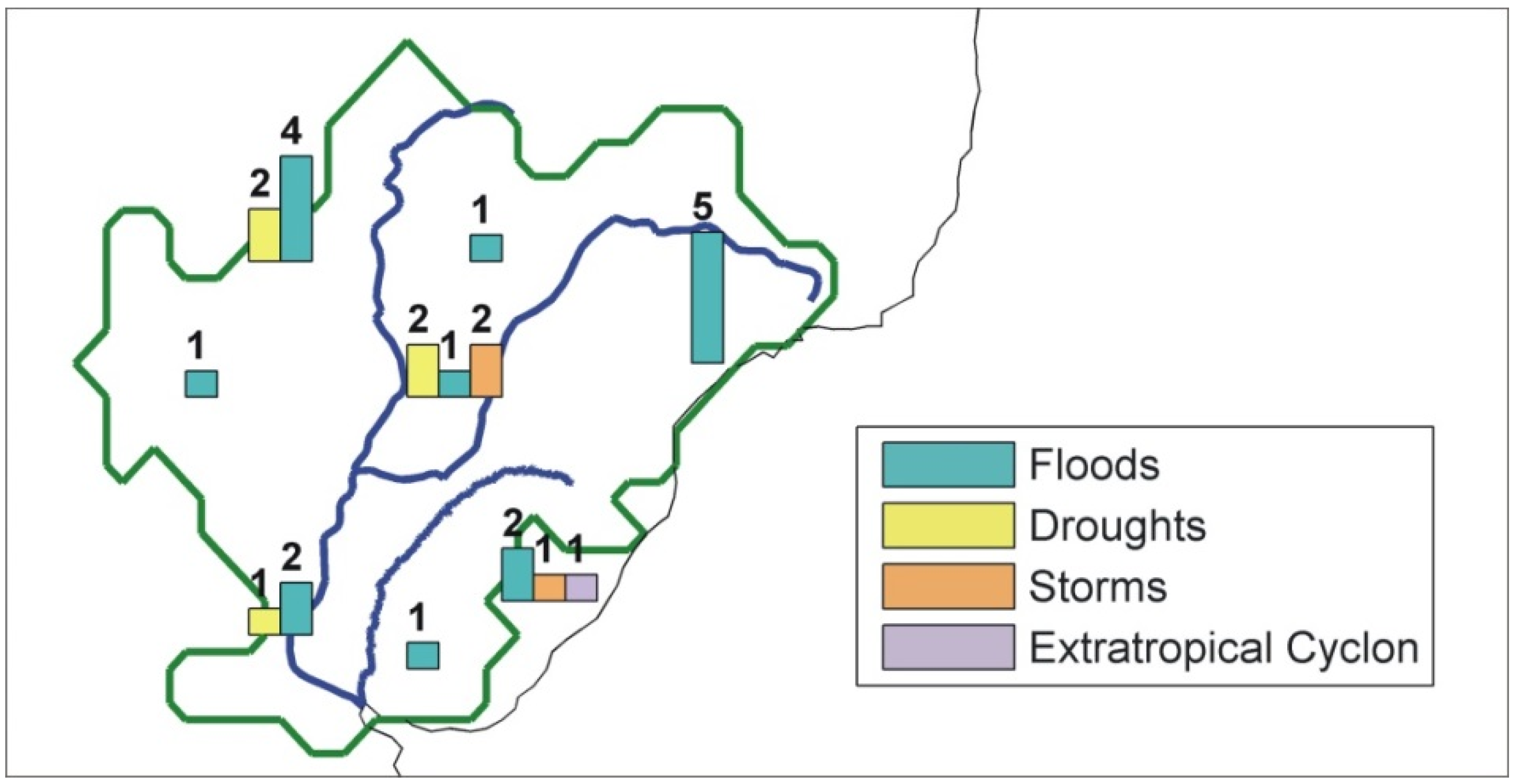
4. Methods
4.1. Scaling
4.2. Harmonization
4.3. Correlation and Principal Component Analysis
4.4. Sample Cross-Covariance Function
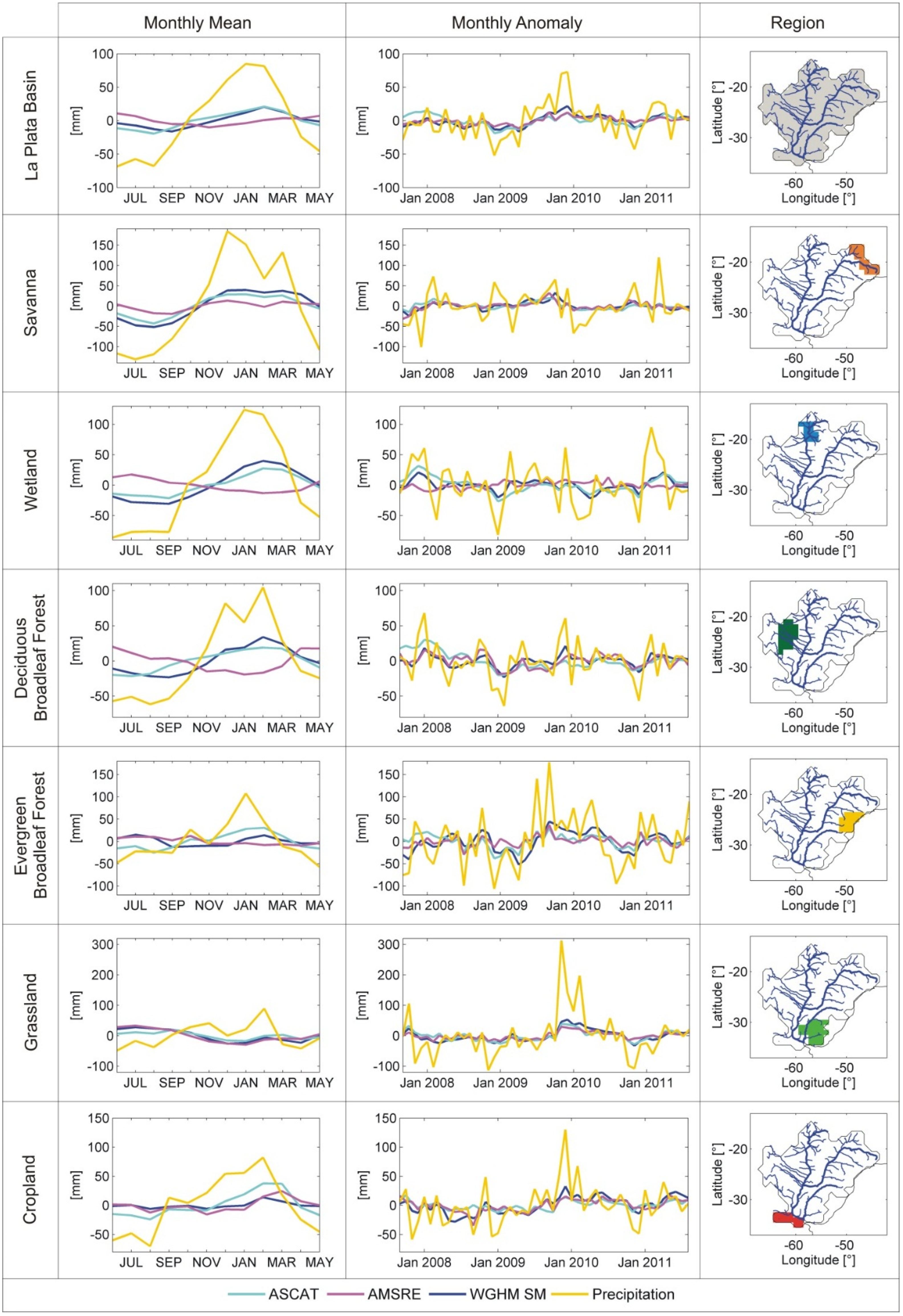
5. Results and Discussion
5.1. Comparison of Soil Moisture Data Sets
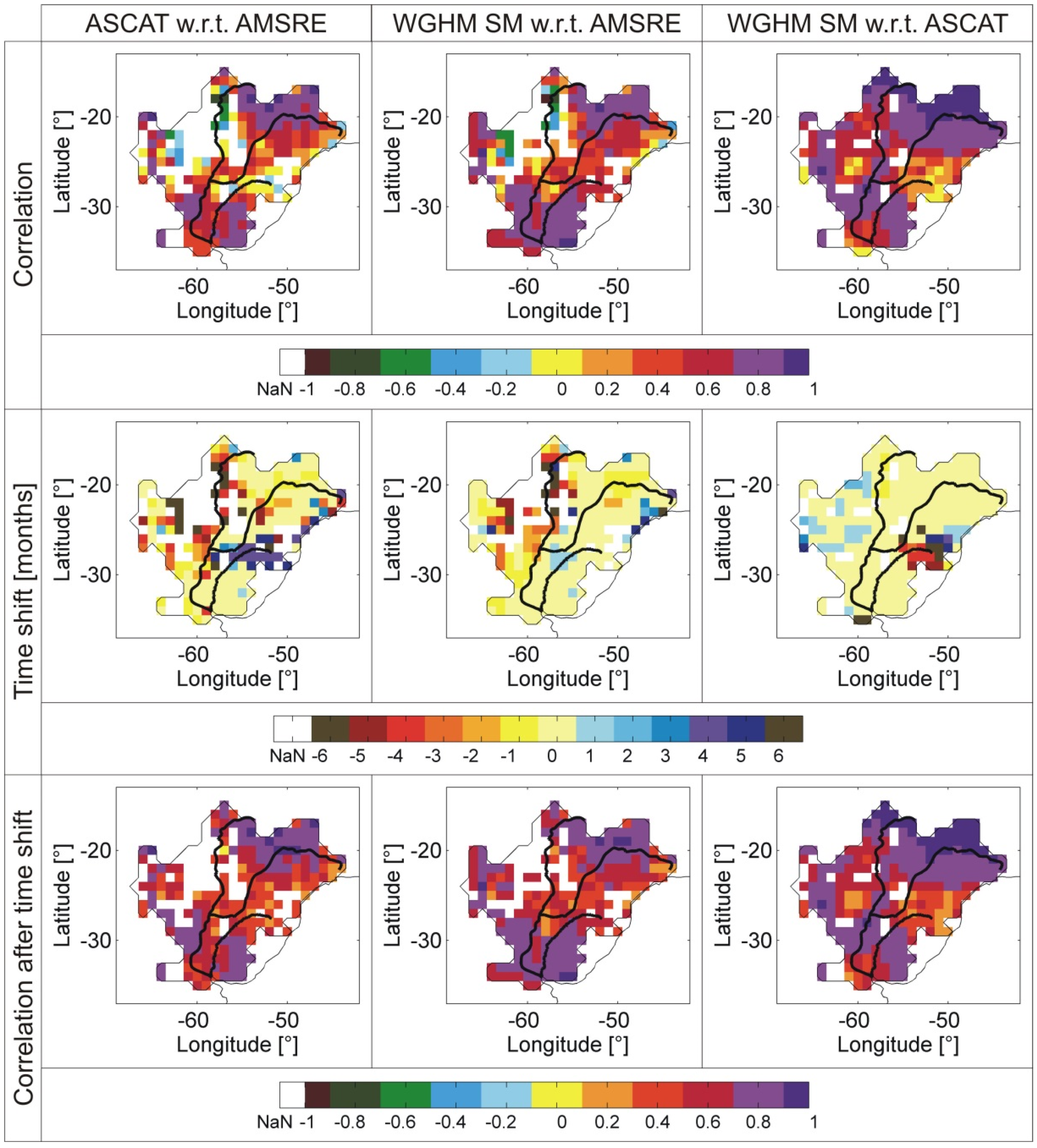
5.2. Hydrological Extremes
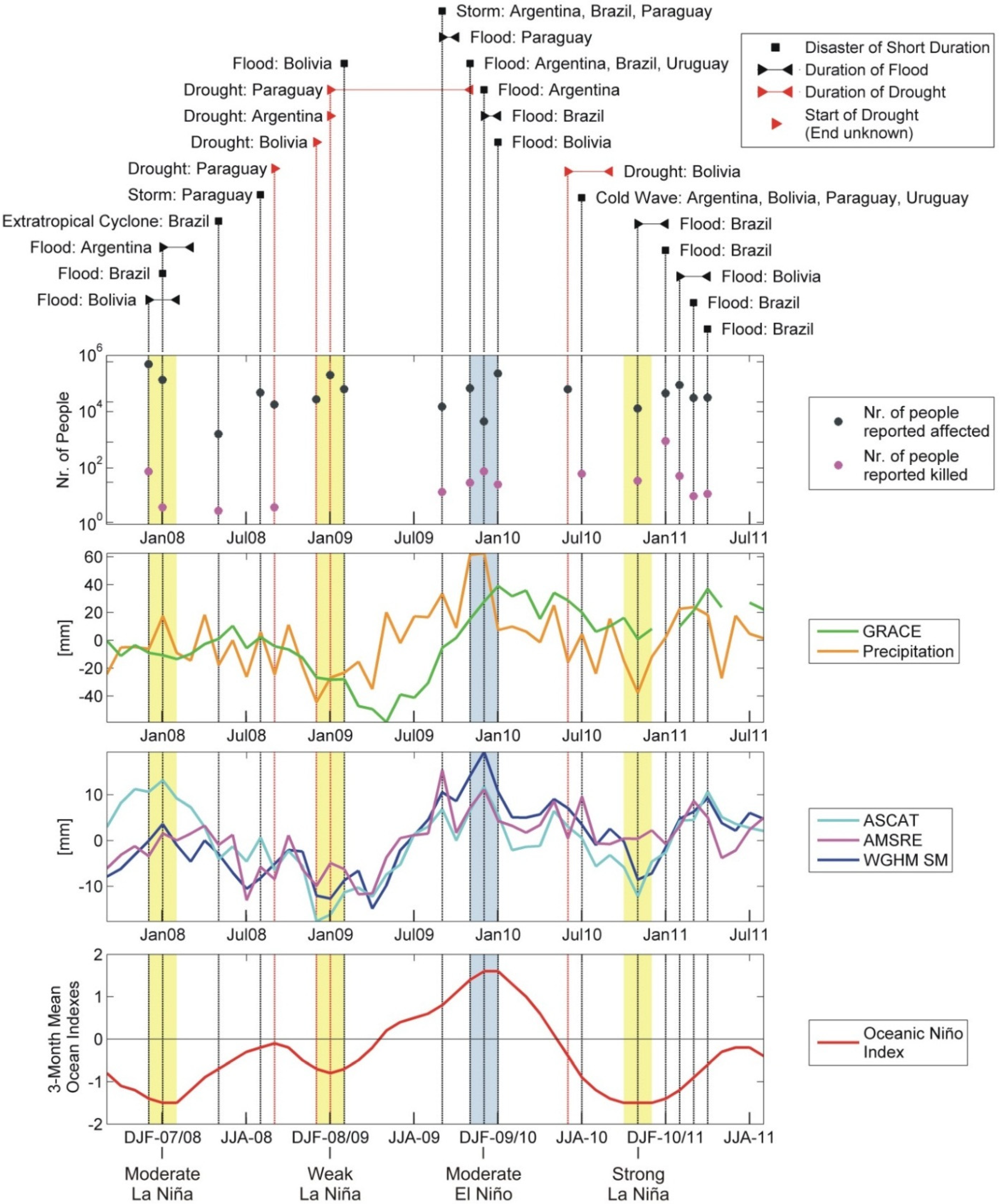
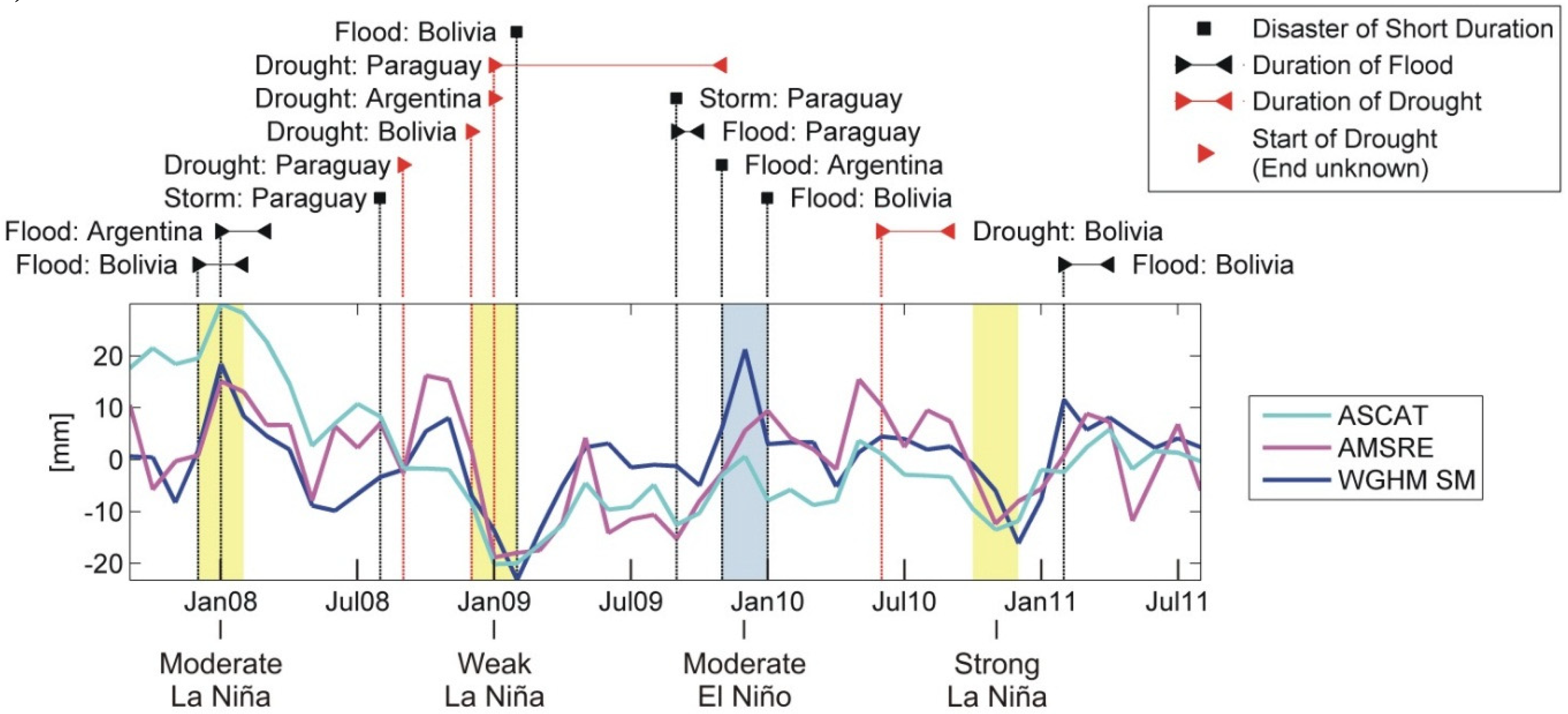
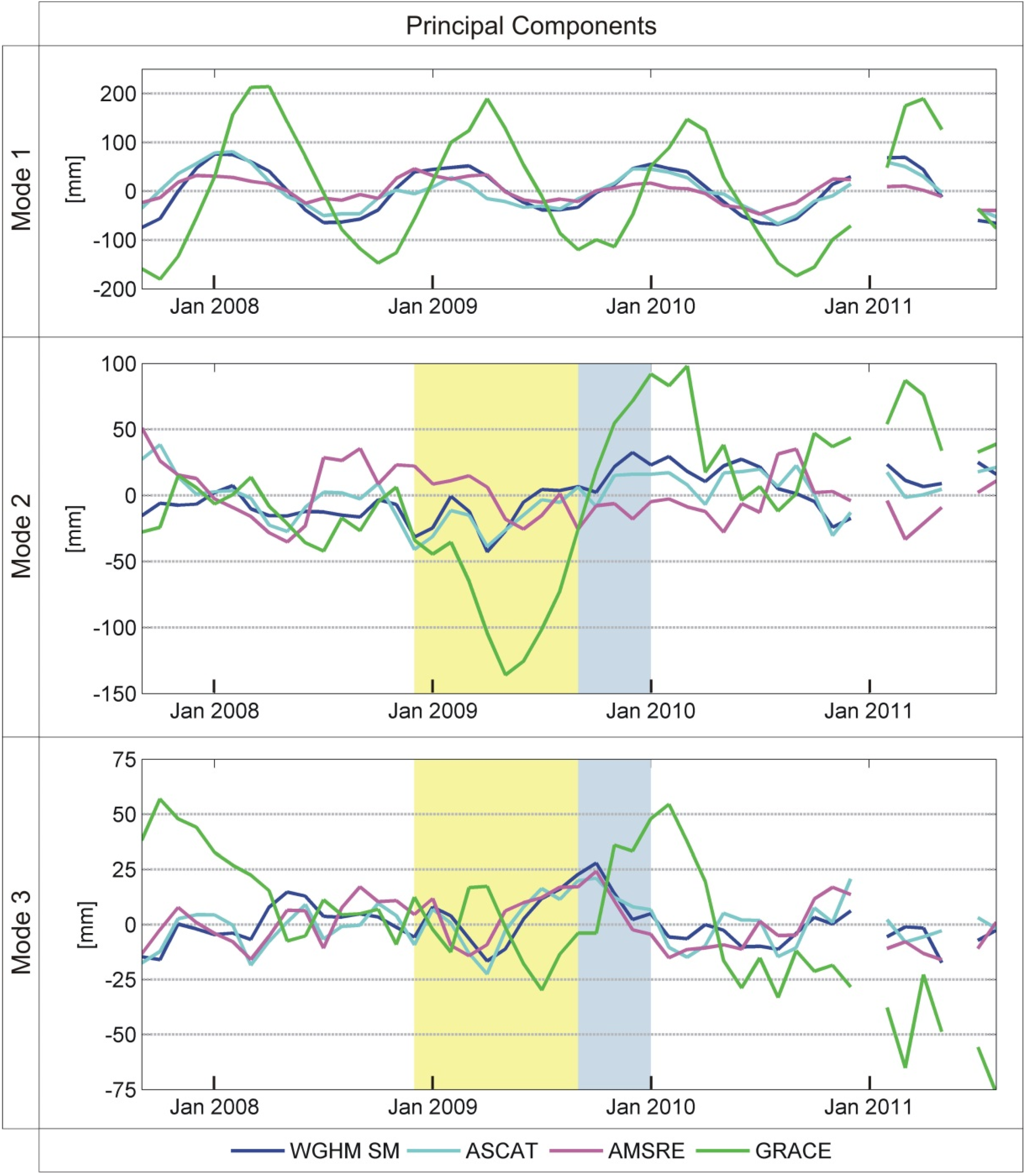
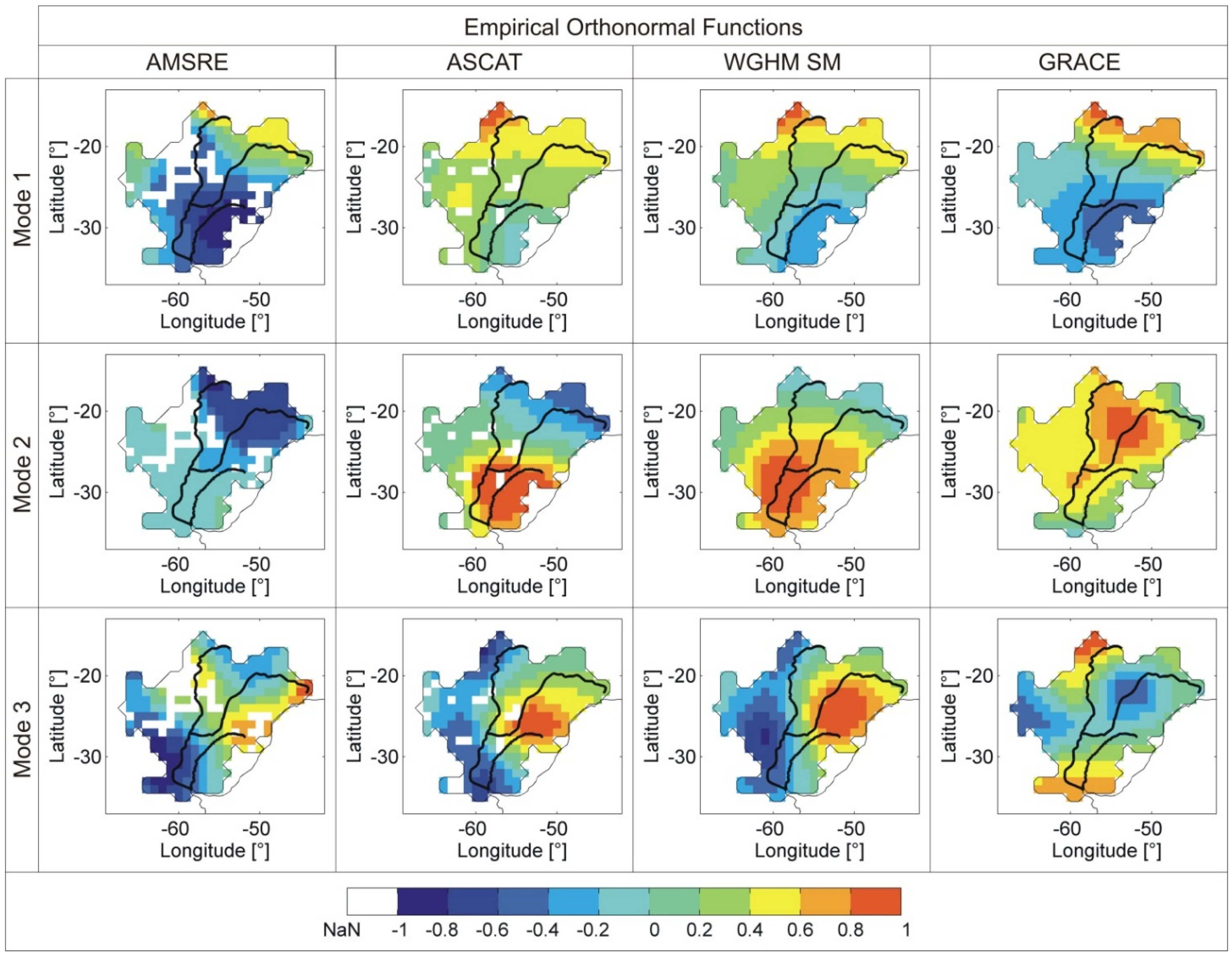
5.3. Soil Moisture and GRACE TWS
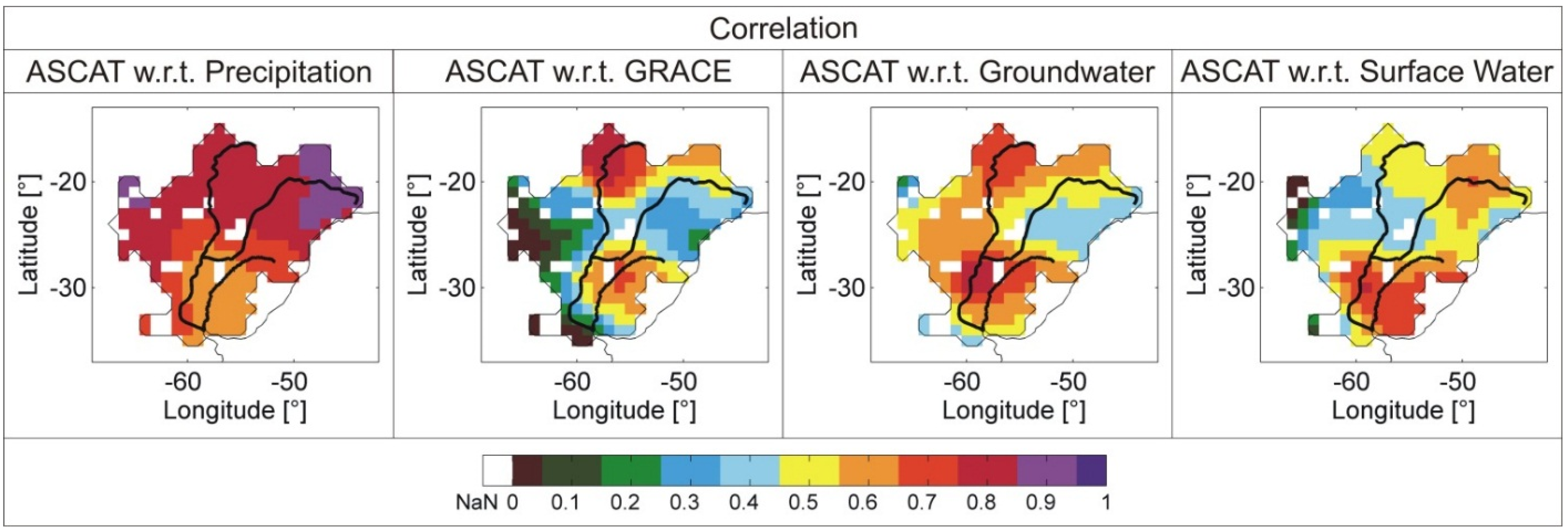
6. Conclusions
Acknowledgments
Author Contributions
Conflicts of Interest
References
- Pozzi, W.; Sheffield, J.; Stefanski, R.; Cripe, D.; Pulwarty, R.; Vogt, J.V.; Heim, R.R.; Brewer, M.J.; Svoboda, M.; Westerhoff, R.; et al. Toward global drought early warning capability: Expanding international cooperation for the development of a framework for monitoring and forecasting. Bull. Am. Meteorol. Soc. 2013, 94, 776–785. [Google Scholar] [CrossRef]
- Kumar, D.N.; Reshmidevi, T.V. Remote sensing applications in water resources. J. Indian Inst. Sci. 2013, 93, 164–187. [Google Scholar]
- Bolten, J.D.; Crow, W.T.; Zhan, X.; Jackson, T.J.; Reynolds, C.A. Evaluating the utility of remotely sensed soil moisture retrievals for operational agricultural drought monitoring. IEEE J. Sel. Top. Appl. Earth Obs. Remote Sens. 2010, 3, 57–66. [Google Scholar] [CrossRef]
- Anderson, W.B.; Zaitchik, B.F.; Hain, C.R.; Anderson, M.C.; Yilmaz, M.T.; Mecikalski, J.; Schultz, L. Towards an integrated soil moisture drought monitor for East Africa. Hydrol. Earth Syst. Sci. 2012, 16, 2893–2913. [Google Scholar] [CrossRef]
- Champagne, C.; McNairn, H.; Berg, A.A. Monitoring agricultural soil moisture extremes in Canada using passive microwave remote sensing. Remote Sens. Environ. 2011, 115, 2434–2444. [Google Scholar] [CrossRef]
- Zhang, A.; Jia, G. Monitoring meteorological drought in semiarid regions using multi-sensor microwave remote sensing data. Remote Sens. Environ. 2013, 134, 12–23. [Google Scholar] [CrossRef]
- Lacava, T.; Cuomo, V.; Di Leo, E.V.; Pergola, N.; Romano, F.; Tramutoli, V. Improving soil wetness variations monitoring from passive microwave satellite data: The case of April 2000 Hungary flood. Remote Sens. Environ. 2005, 96, 135–148. [Google Scholar] [CrossRef]
- Scipal, K.; Scheffler, C.; Wagner, W. Soil moisture-runoff relation at the catchment scale as observed with coarse resolution microwave remote sensing. Hydrol. Earth Syst. Sci. 2005, 9, 173–183. [Google Scholar] [CrossRef]
- Brocca, L.; Melone, F.; Moramarco, T.; Wagner, W.; Naeimi, V.; Bartalis, Z.; Hasenauer, S. Improving runoff prediction through the assimilation of the ASCAT soil moisture product. Hydrol. Earth Syst. Sci. 2010, 14, 1881–1893. [Google Scholar] [CrossRef]
- Brocca, L.; Moramarco, T.; Melone, F.; Wagner, W.; Hasenauer, S.; Hahn, S. Assimilation of surface- and root-zone ASCAT soil moisture products into rainfall-runoff modeling. IEEE Trans. Geosci. Remote Sens. 2012, 50, 2542–2555. [Google Scholar] [CrossRef]
- Simelton, E.; Fraser, E.D.G.; Termansen, M.; Benton, T.G.; Gosling, S.N.; South, A.; Arnell, N.W.; Challinor, A.J.; Dougill, A.J.; Forster, P.M. The socioeconomics of food crop production and climate change vulnerability: A global scale quantitative analysis of how grain crops are sensitive to drought. Glob. Chang. Biol. 2012, 9, 161–185. [Google Scholar] [CrossRef]
- Ochsner, T.E.; Cosh, M.H.; Cuenca, R.H.; Dorigo, W.A.; Draper, C.S.; Hagimoto, Y.; Kerr, Y.H.; Njoku, E.G.; Small, E.E.; Zreda, M. State of the art in large-scale soil moisture monitoring. Soil Sci. Soc. Am. J. 2013, 77. [Google Scholar] [CrossRef] [Green Version]
- Seitz, F.; Schmidt, M.; Shum, C.K. Signals of extreme weather conditions in Central Europe in GRACE 4-D hydrological mass variations. Earth Planet. Sci. Lett. 2008, 268, 165–170. [Google Scholar] [CrossRef]
- Reager, J.T.; Famiglietti, J.S. Global terrestrial water storage capacity and flood potential using GRACE. Geophys. Res. Lett. 2009, 36. [Google Scholar] [CrossRef]
- Yirdaw, S.Z.; Snelgrove, K.R.; Agboma, C.O. GRACE satellite observations of terrestrial moisture changes for drought characterization in the Canadian Prairie. J. Hydrol. 2008, 356, 84–92. [Google Scholar] [CrossRef]
- Schmidt, M.; Seitz, F.; Shum, C.K. Regional four-dimensional hydrological mass variations from GRACE, atmospheric flux convergence, and river gauge data. J. Geophys. Res. 2008, 113. [Google Scholar] [CrossRef]
- Abelen, S.; Seitz, F. Relating satellite gravimetry data to global soil moisture products via data harmonization and correlation analysis. Remote Sens. Environ. 2013, 136, 89–98. [Google Scholar] [CrossRef]
- Houborg, R.; Rodell, M.; Li, B.; Reichle, R.; Zaitchik, B.F. Drought indicators based on model-assimilated Gravity Recovery and Climate Experiment (GRACE) terrestrial water storage observations. Water Resour. Res. 2012, 48. [Google Scholar] [CrossRef]
- Zaitchik, B.F.; Rodell, M.; Reichle, R.H. Assimilation of GRACE terrestrial water storage data into a land surface model: Results for the Mississippi River Basin. J. Hydrometeorol. 2008, 9, 535–548. [Google Scholar] [CrossRef]
- Chen, J.L.; Wilson, C.R.; Tapley, B.D.; Longuevergne, L.; Yang, Z.L.; Scanlon, B.R. Recent La Plata basin drought conditions observed by satellite gravimetry. J. Geophys. Res. 2010, 115. [Google Scholar] [CrossRef]
- Pereira, A.; Miranda, S.; Pacino, M.C.; Forsberg, R. Water storage changes from GRACE data in the La Plata Basin. Geod. Planet. Earth 2012, 136, 613–618. [Google Scholar]
- Pereira, A.; Pacino, M.C. Annual and seasonal water storage changes detected from GRACE data in the La Plata Basin. Phys. Earth Planet. Inter. 2012, 212–213, 88–99. [Google Scholar] [CrossRef]
- Frappart, F.; Seoane, L.; Ramillien, G. Validation of GRACE-derived terrestrial water storage from a regional approach over South America. Remote Sens. Environ. 2013, 137, 69–83. [Google Scholar] [CrossRef]
- Chen, J.L.; Wilson, C.R.; Tapley, B.D.; Yang, Z.L.; Niu, G.Y. 2005 drought event in the Amazon River basin as measured by GRACE and estimated by climate models. J. Geophys. Res. Solid Earth 2009, 114, 1–9. [Google Scholar] [CrossRef]
- Chen, J.L.; Wilson, C.R.; Tapley, B.D. The 2009 exceptional Amazon flood and interannual terrestrial water storage change observed by GRACE. Water Resour. Res. 2010, 46. [Google Scholar] [CrossRef]
- Xavier, L.; Becker, M.; Cazenave, A.; Longuevergne, L.; Llovel, W.; Filho, O.C.R. Interannual variability in water storage over 2003–2008 in the Amazon Basin from GRACE space gravimetry, in situ river level and precipitation data. Remote Sens. Environ. 2010, 114, 1629–1637. [Google Scholar] [CrossRef] [Green Version]
- Chen, Y.; Velicogna, I.; Famiglietti, J.S.; Randerson, J.T. Satellite observations of terrestrial water storage provide early warning information about drought and fire season severity in the Amazon. J. Geophys. Res.: Biogeosci. 2013, 118, 495–504. [Google Scholar] [CrossRef]
- Frappart, F.; Ramillien, G.; Ronchail, J. Changes in terrestrial water storage versus rainfall and discharges in the Amazon basin. Int. J. Climatol. 2013, 33, 3029–3046. [Google Scholar] [CrossRef] [Green Version]
- Ferrazzoli, P.; Member, S.; Rahmoune, R.; Moccia, F.; Grings, F.; Salvia, M.; Barber, M.; Douna, V.; Karszenbaum, H.; Soldano, A.; et al. The effect of rain and flooding events on AMSR-E signatures of La Plata Basin, Argentina. IEEE J. Sel. Top. Appl. Earth Obs. Remote Sens. 2010, 3, 81–90. [Google Scholar] [CrossRef]
- Su, F.; Lettenmaier, D.P. Estimation of the surface water budget of the La Plata Basin. J. Hydrometeorol. 2009, 10, 981–998. [Google Scholar] [CrossRef]
- Caffera, R.M.; Berbery, E.H. La Plata Basin climatology. In Climate Change in the La Plata Basin; Barros, V., Clarke, R., Diás, P.S., Eds.; Research Centre for Sea and Atmosphere CIMA-CONICET/FCEN-UBA: Buenos Aires, Argentina, 2006; pp. 16–34. [Google Scholar]
- Politis, G. The pampas and campos of South America. In the Handbook of South American Archaeology; Silverman, H., Isbell, W.H., Eds.; Springer: New York, NY, USA, 2008; pp. 235–260. [Google Scholar]
- Royo Pallarés, O.; Berretta, E.J.; Maraschin, G.E. The South American Campos ecosystem. In Grasslands of the World; Suttie, J.M., Reynolds, S.G., Batello, C., Eds.; Food and Agricultural Organization of the United Nations: Rome, Italy, 2005; pp. 171–219. [Google Scholar]
- Viglizzo, E.F.; Frank, F.C. Land-use options for Del Plata Basin in South America: Tradeoffs analysis based on ecosystem service provision. Ecol. Econ. 2006, 57, 140–151. [Google Scholar] [CrossRef]
- Coronel, G.; Menéndez, Á.; Chamorro, L. Physiography and hydrlogy. In Climate Change in the La Plata Basin; Barros, V., Clarke, R., Días, P.S., Eds.; Research Centre for Sea and Atmosphere CIMA-CONICET/FCEN-UBA: Buenos Aires, Argentina, 2006; pp. 44–60. [Google Scholar]
- Berbery, E.H.; Barros, V.R. The hydrologic cycle of the La Plata Basin in South America. J. Hydrometeorol. 2002, 3, 630–645. [Google Scholar] [CrossRef]
- Garcia, N.O. The spatial variability of runoff and precipitation in the Rio de la Plata basin. Hydrol. Sci. J. 1996, 41, 279–300. [Google Scholar] [CrossRef]
- Klink, C.A.; Machado, R.B. Conservation of the Brazilian Cerrado. Conserv. biol. 2005, 19, 707–713. [Google Scholar] [CrossRef]
- Ribeiro, M.C.; Metzger, J.P.; Martensen, A.C.; Ponzoni, F.J.; Hirota, M.M. The Brazilian Atlantic forest: How much is left, and how is the remaining forest distributed? Implications for conservation. Biol. Conserv. 2009, 142, 1141–1153. [Google Scholar] [CrossRef]
- Grimm, A.M.; Barros, V.R.; Doyle, M.E. Climate variability in Southern South America associated with El Niño and La Niña Events. J. Clim. 2000, 13, 35–58. [Google Scholar] [CrossRef]
- Dahle, C.; Flechtner, F.; Gruber, C.; König, D.; König, R.; Michalak, G.; Neumayer, K.-H. GFZ GRACE Level-2 Processing Standards Document for Level-2 Product Release 0005; (Scientific Technical Report STR12/02 – Data, Revised Edition, January 2013); GFZ German Research Centre for Geosciences: Potsdam, Germany, 2012. [Google Scholar]
- Bartalis, Z.; Wagner, W.; Naeimi, V.; Hasenauer, S.; Scipal, K.; Bonekamp, H.; Figa, J.; Anderson, C. Initial soil moisture retrievals from the METOP-A Advanced Scatterometer (ASCAT). Geophys. Res. Lett. 2007, 34. [Google Scholar] [CrossRef]
- Owe, M.; de Jeu, R.; Holmes, T. Multisensor historical climatology of satellite-derived global land surface moisture. J. Geophys. Res. 2008, 113. [Google Scholar] [CrossRef]
- Müller Schmied, H.; Eisner, S.; Franz, D.; Wattenbach, M.; Portmann, F.T.; Flörke, M.; Döll, P. Sensitivity of simulated global-scale freshwater fluxes and storages to input data, hydrological model structure, human water use and calibration. Hydrol. Earth Syst. Sci. Discuss. 2014, 11, 1583–1649. [Google Scholar] [CrossRef]
- Draper, C.S.; Walker, J.P.; Steinle, P.J.; de Jeu, R.A.M.; Holmes, T.R.H. An evaluation of AMSR-E derived soil moisture over Australia. Remote Sens. Environ. 2009, 113, 703–710. [Google Scholar] [CrossRef]
- Wagner, W.; Naeimi, V.; Scipal, K.; Jeu, R.; Martínez-Fernández, J. Soil moisture from operational meteorological satellites. Hydrogeol. J. 2006, 15, 121–131. [Google Scholar] [CrossRef]
- Liu, Y.Y.; Parinussa, R.M.; Dorigo, W.A.; De Jeu, R.A.M.; Wagner, W.; Van Dijk, A.I.J.M.; Mccabe, M.F.; Evans, J.P. Developing an improved soil moisture dataset by blending passive and active microwave satellite-based retrievals. Hydrol. Earth Syst. Sci. 2011, 15, 425–436. [Google Scholar] [CrossRef] [Green Version]
- Döll, P.; Kaspar, F.; Lehner, B. A global hydrological model for deriving water availability indicators: Model tuning and validation. J. Hydrol. 2003, 270, 105–134. [Google Scholar] [CrossRef]
- Güntner, A.; Stuck, J.; Werth, S.; Döll, P.; Verzano, K.; Merz, B. A global analysis of temporal and spatial variations in continental water storage. Water Resour. Res. 2007, 43. [Google Scholar] [CrossRef]
- Forootan, E.; Awange, J.L.; Kusche, J.; Heck, B.; Eicker, A. Independent patterns of water mass anomalies over Australia from satellite data and models. Remote Sens. Environ. 2012, 124, 427–443. [Google Scholar] [CrossRef]
- Schmidt, R.; Schwintzer, P.; Flechtner, F.; Reigber, C.; Gunter, A.; Doll, P.; Ramillien, G.; Cazenave, A.; Petrovic, S.; Jochmann, H. GRACE observations of changes in continental water storage. Glob. Planet. Chang. 2006, 50, 112–126. [Google Scholar] [CrossRef]
- Schmidt, R.; Petrovic, S.; Güntner, A.; Barthelmes, F.; Wünsch, J.; Kusche, J. Periodic components of water storage changes from GRACE and global hydrology models. J. Geophys. Res. 2008, 113. [Google Scholar] [CrossRef]
- Papa, F.; Güntner, A.; Frappart, F.; Prigent, C.; Rossow, W.B. Variations of surface water extent and water storage in large river basins: A comparison of different global data sources. Geophys. Res. Lett. 2008, 35. [Google Scholar] [CrossRef] [Green Version]
- Schneider, U.; Becker, A.; Finger, P.; Meyer-Christoffer, A.; Rudolf, B.; Ziese, M. GPCC Monitoring Product: Near Real-Time Monthly Land-Surface Precipitation from Rain-Gauges based on SYNOP and CLIMAT Data; Global Precipitation Climatology Centre (GPCC): Offenbach/Main, Germany, 2011. [Google Scholar]
- Geruo, A.; Wahr, J.; Zhong, S. Computations of the viscoelastic response of a 3-D compressible Earth to surface loading: An application to glacial isostatic adjustment in Antarctica and Canada. Geophys. J. Int. 2012, 192, 557–572. [Google Scholar]
- Schnitzer, S.; Seitz, F.; Eicker, A.; Guntner, A.; Wattenbach, M.; Menzel, A. Estimation of soil loss by water erosion in the Chinese Loess Plateau using Universal Soil Loss Equation and GRACE. Geophys. J. Int. 2013, 193, 1283–1290. [Google Scholar] [CrossRef]
- Rodell, M.; Chao, B.F.; Au, A.Y.; Kimball, J.S.; McDonald, K.C. Global biomass variation and its geodynamic effects: 1982–1998. Earth Interact. 2005, 9, 1–19. [Google Scholar] [CrossRef]
- Swenson, S.; Wahr, J. Post-processing removal of correlated errors in GRACE data. Geophys. Res. Lett. 2006, 33. [Google Scholar] [CrossRef]
- Wahr, J.; Molenaar, M.; Bryan, F. Time variability of the earth’s gravity field: Hydrological and oceanic effects and their possible detection using GRACE. J. Geophys. Res. 1998, 103, 205–229. [Google Scholar] [CrossRef]
- Bettadpur, S. Level-2 Gravity Field Product User Handbook; GRACE 327-734; University of Texas Center for Space Research (UTCSR): Austin, TX, USA, 2007. [Google Scholar]
- Changes to the Oceanic Niño Index (ONI). Available online: http://www.cpc.noaa.gov/products/analysis_monitoring/ensostuff/ensoyears.shtml (accessed on 6 September 2014).
- Larkin, N.K. Global seasonal temperature and precipitation anomalies during El Niño autumn and winter. Geophys. Res. Lett. 2005, 32. [Google Scholar] [CrossRef]
- El Niño and La Niña Years and Intensities Based on Oceanic Niño Index (ONI). Available online: http://ggweather.com/enso/oni.htm (accessed on 6 September 2014).
- EM-DAT The International Disaster Database, Centre for Research on the Epidemiology of Disasters—CRED. Available online: http://www.emdat.be/criteria-and-definition (accessed on 16 October 2014).
- South America: Population density. Map/Still. Available online: http://kids.britannica.com/comptons/art-160672 (accessed on 31 October 2014).
- Albergel, C.; Rüdiger, C.; Pellarin, T.; Calvet, J.-C.; Fritz, N.; Froissard, F.; Suquia, D.; Petitpa, A.; Piguet, B.; Martin, E. From near-surface to root-zone soil moisture using an exponential filter: An assessment of the method based on in-situ observations and model simulations. Hydrol. Earth Syst. Sci. Discuss. 2008, 5, 1603–1640. [Google Scholar] [CrossRef]
- Wagner, W.; Lemoine, G.; Rott, H. A method for estimating soil moisture from ERS scatterometer and soil data. Remote Sens. Environ. 1999, 70, 191–207. [Google Scholar] [CrossRef]
- Rodgers, J.L.; Nicewander, W.A. Thirteen ways to look at the correlation coefficient. Am. Stat. 2008, 42, 59–66. [Google Scholar] [CrossRef]
- Draper, C.S.; Reichle, R.H.; De Lannoy, G.J.M.; Liu, Q. Assimilation of passive and active microwave soil moisture retrievals. Geophys. Res. Lett. 2012, 39. [Google Scholar] [CrossRef] [Green Version]
- Albergel, C.; Dorigo, W.; Balsamo, G.; Muñoz-Sabater, J.; de Rosnay, P.; Isaksen, L.; Brocca, L.; de Jeu, R.; Wagner, W. Monitoring multi-decadal satellite earth observation of soil moisture products through land surface reanalyses. Remote Sens. Environ. 2013, 138, 77–89. [Google Scholar] [CrossRef]
- Albergel, C.; Dorigo, W.; Reichle, R.H.; Balsamo, G.; de Rosnay, P.; Munoz-Sabater, J.; Isaksen, L.; de Jeu, R.; Wagner, W. Skill and global trend analysis of soil moisture from reanalyses and microwave remote sensing. J. Hydrometeorol. 2013, 14, 1259–1277. [Google Scholar] [CrossRef]
- Preisendorfer, R.W.; Mobley, C. Principal Component Analysis in Meteorology and Oceanography; Elsevier: Amsterdam, The Netherland, 1988. [Google Scholar]
- Abelen, S.; Seitz, F.; Schmidt, M.; Güntner, A. Analysis of regional variations in soil moisture by means of remote sensing, satellite gravimetry and hydrological modelling. In GRACE, Remote Sensing and Ground-Based Methods in Multi-Scale Hydrology; IAHS Red Book Series, Nr. 343; International Association of Hydrological Sciences: Oxford, UK, 2011; pp. 9–15. [Google Scholar]
- Box, G.E.P.; Jenkins, G.M.; Reinsel, G.C. Time Series Analysis: Forecasting and Control, 3rd ed.; Prentice Hall: Englewood Cliff, NJ, USA, 1994. [Google Scholar]
- Jeu, R.A.M.; Wagner, W.; Holmes, T.R.H.; Dolman, A.J.; Giesen, N.C.; Friesen, J. Global soil moisture patterns observed by space borne microwave radiometers and scatterometers. Surv. Geophys. 2008, 29, 399–420. [Google Scholar] [CrossRef]
- Gallant, A.J.E.; Karoly, D.J. Atypical influence of the 2007 La Niña on rainfall and temperature in southeastern Australia. Geophys. Res. Lett. 2009, 36. [Google Scholar] [CrossRef]
- Mandeville, P.; Campagnoni, R.; Bernardi, R. Informe de Estado de Situacíon—SITREP Sequía e Incendios en Uruguay. Available online: http://reliefweb.int/sites/reliefweb.int/files/resources/7812513E37D9B60C052575400075237E-Informe_completo.pdf (accessed on 5 November 2014).
- United Nations Office for Diaster Risk reduction (UNISDR). Living with Risk: A Global Review of Disaster Reduction Initiatives; United Nations Inter-Agency Secretariat of the International Strategy for Disaster Reduction (UN/ISDR): Geneva, Switzerland, 2004. [Google Scholar]
- Hamilton, S.K.; Station, W.K.K.B.; Corners, H. Human impacts on hydrology in the Pantanal wetland of South America. Water Sci. Technol. 2002, 45, 35–44. [Google Scholar] [PubMed]
© 2015 by the authors; licensee MDPI, Basel, Switzerland. This article is an open access article distributed under the terms and conditions of the Creative Commons Attribution license (http://creativecommons.org/licenses/by/4.0/).
Share and Cite
Abelen, S.; Seitz, F.; Abarca-del-Rio, R.; Güntner, A. Droughts and Floods in the La Plata Basin in Soil Moisture Data and GRACE. Remote Sens. 2015, 7, 7324-7349. https://doi.org/10.3390/rs70607324
Abelen S, Seitz F, Abarca-del-Rio R, Güntner A. Droughts and Floods in the La Plata Basin in Soil Moisture Data and GRACE. Remote Sensing. 2015; 7(6):7324-7349. https://doi.org/10.3390/rs70607324
Chicago/Turabian StyleAbelen, Sarah, Florian Seitz, Rodrigo Abarca-del-Rio, and Andreas Güntner. 2015. "Droughts and Floods in the La Plata Basin in Soil Moisture Data and GRACE" Remote Sensing 7, no. 6: 7324-7349. https://doi.org/10.3390/rs70607324







